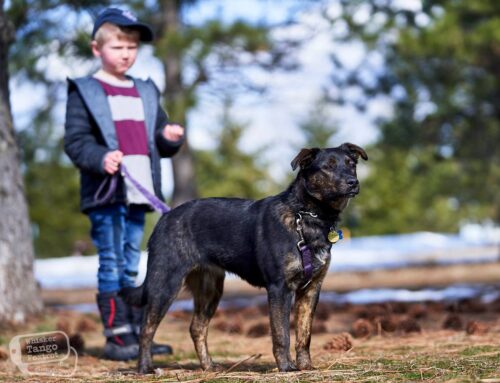Hi everyone! Ever since I gave birth to my daughter, Emma, and people have seen how marvelously she and the dogs get along, I’ve been getting lots of questions about introducing dogs and babies. Here are some tips to help safely introduce dogs to a newborn baby.
Keep in mind, this advice does *not* substitute working with a professional trainer. I am giving this advice assuming that your dog is friendly and does not have any behavioral issues. If your dog is not safe, or is aggressive, fearful, reactive or unstable in any way, then my advice is to seek professional help. NEVER introduce an unstable dog to a newborn baby.
After coming home from the hospital with your baby, here’s what you can do to properly introduce your dogs to your newborn baby.
First, take your time.
There is absolutely no reason to introduce your dogs to the baby right away. Because I had postpartum preeclampsia, we waited a full 10 days before introducing the dogs to Emma. That gave me and my husband both time to rest, recuperate and give the dogs some one-on-one time before allowing them to meet Emma. We wanted to make sure they were well-exercised and calm, not excited, during the introduction.
Second, leash your dogs and introduce them one at a time.
It horrifies me to see videos of people coming home from the hospital and placing the car seat on the ground so the dogs can come up and say hi to the baby. This is TERRIBLE and horribly irresponsible and reckless. What if the dogs react poorly to the baby crying and become aggressive? What if the dogs jump on the baby or nip her excitedly? Even if the dogs just lick the baby’s face, that is not sanitary for a newborn baby. The videos you’re seeing on YouTube are of introductions that went well. What about the ones that didn’t? Don’t assume yours will work out just because someone else’s did.
Leash your dog and have someone walk him up to you, while seated with the baby safely in your arms. Then have the dog stop short, allow him to sniff the baby but not lick her. He does not need to get in her face or be pushy. Sniffing from a foot away is sufficient. Praise your dog calmly then walk him away from the baby. You can repeat if you’d like. Always end on a good note. Do this with each dog. Control their body using the leash. Do not allow him to paw at the baby or jump on the baby. Do this daily until the dogs are not excitable when introduced.
This may seem unnecessarily slow, but we’re talking about a newborn baby. There’s no such thing as being too safe with a precious child!
Next, keep your dogs leashed anytime they are around the baby.
And never put the baby at their level or within their reach. You need to know without a shadow of a doubt that your dog understands what he can and cannot do. He can sniff the baby, maybe lick her hands or feet. But he cannot lick her face, paw at her, jump on her or trample her.
We never gave our dogs access to Emma for the first few months. The closest they got to her was when they approached and I was holding her. I allowed them to calmly and respectfully check her out, but did not allow them to get in her space. And I never placed her on the ground by them. There is literally no reason to compromise your child’s safety for a photo op.
Once we knew the dogs understood they had to be calm and respectful, the leashes came off. They spent time together mostly in the evenings when the dogs were tired and their needs had been met and Emma was calm and content as well. The dogs were placed in a down, and taught to stay out of Emma’s space. This was our way of setting them up for success and advocating for Emma.
These are the steps we took to set the dogs up for success and keep Emma safe.
We didn’t want them to accidentally step on her or scratch her, lick her face or make her uncomfortable at any point. Over time they got used to her crying and she got used to them barking. We never rushed anything. And we always placed Emma’s safety as the top priority.
The dogs learned that Emma is important to us and someone they must be respectful of. By teaching them boundaries, rules and limitations with our newborn baby, we are setting them up for success as her future playmates and guardians. We want them to have a healthy relationship based on trust and respect at the forefront, so that we can live in harmony as one big, happy family!
I hope this helps. If you’d like to learn more about setting your dog up for success BEFORE bringing home your baby, stay tuned for my upcoming article: “How to get your dog ready for a newborn baby!”










Leave A Comment